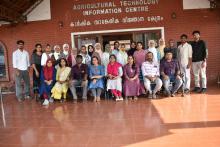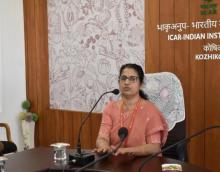Our history
Crop Improvement Division of IISR possesses world's largest germplasm collection in various spices. A total of 25 high yielding and high quality spices varieties have been released. Vegetative and micro propagation techniques were standardized.
The Division of Crop Improvement has had a long and lustrous history that spans some 40 years. Since its inception, the Division has provided a home to innovative scientists who had made it their lives' work to reduce poverty through spices crop improvement research. Significant advancements in spices science and technologies would not have been possible had it not been for Crop Improvement Division's commitment.
| Name of Head of the Division | Period of service | Specialization |
|---|---|---|
|
|
Biotechnology | |
| Dr. K.V. Saji | Jun 2022 - | Economic Botany |
| Dr. J. Rema | Feb 2018 – May 2022 | Horticulture Science |
| Dr. B. Sasikumar | Dec 2013- Jan 2018 | Plant Breeding |
| Sri. B. Krishnamoorthy | Jan 1999- Nov 2013 | Plant Breeding |
| Dr. P.N. Ravindran | 1995- Jan 1999 | Botany and Cytogenetics |
| Name | Designation | Specialization |
|---|---|---|
| Dr. T. E. Sheeja | Principal Scientist & Head | Plant Biotechnology |
| Dr. D. Prasath | Principal Scientist | Horticulture Science |
| Dr. Divya P Syamaladevi | Senior Scientist | Agricultural Biotechnology |
| Dr.Sajesh VK | Senior Scientist | Agricultural Extension |
| Dr. Sharon Aravind | Scientist | Spices & Plantation Crops |
| Ms. S. Aarthi | Scientist | Horticulture |
| Dr. Sona Charles | Scientist | Agricultural Bioinformatics |
| Mr. V A. Muhammed Nissar | Scientist | Horticulture |
| Mr.Mukesh Sankar.S | Scientist | Quantitative genetics, Marker assisted plant breeding and Genetical data analysis |
| Dr.Muhammed Azharudheen TP | Scientist | Molecular breeding |
| Dr. Maneesha S.R. | Scientist | Tropical fruit crops especially, Kokum; medicinal and aromatic crops; Agro- Eco Tourism |
| Dr. M. S. Shivakumar | Scientist | Plant Breeding |
| Ms. H. J. Akshitha | Scientist | Horticulture |
| Mr. Honnappa Asangi | Scientist | Spices, Plantation, Medicinal and Aromatic Plants |
| Mr. A Sudhakaran | Senior Technical Officer | Art and Photography |
| Mr. I P Vijesh Kumar | Technical Assistant | |
| Research Fellows | ||
| Ms. Sumayya Hassan | PhD Scholar | Botany |
| Ms. Aswathi A P | CSIR-UGC JRF | Biological Sciences |
Spices-breeding research begins with its Germplasm Bank, a remarkable living catalogue of genetic diversity comprising over 5000 unique collections of black pepper, ginger, turmeric and tree spices.
We've developed a number of varieties better suited to Indian growing conditions, with good productivity and desired quality characteristics.
The spice crops on which crop improvement research is being conducted include
Black pepper (Piper nigrum Linn.),
Cardamom (Elettaria cardamomum Maton),
Ginger (Zingiber officinale Rosc.),
Turmeric (Curcuma longa Linn.),
Cinnamon (Cinnamomum verum J. Presl.),
Cassia (C. cassia Nees ex Blume),
Clove (Syzygium aromaticum (L.) Merrill & Perry),
Nutmeg (Myristica fragrans Houtt.),
Allspice (Pimenta dioica (L.) Merrill & Perry),
Garcinia (Garcinia gummi-gutta (L.) N. Robson and G. indica Choisy) and
Vanilla (Vanilla planifolia Jacks. ex Andrews).
Genetic diversity
Indian Institute of Spices Research possesses world's largest germplasm collection in various spices.
| Crop | Germplasm status |
|---|---|
| Black pepper | 2695 |
| Ginger | 659 |
| Turmeric | 1270 |
| Cardamom | 442 |
| Cinnamon | 336 |
| Nutmeg | 484 |
| Clove | 223 |
| Garcinia | 116 |
| Vanilla | 93 |
Conserving germplasm
Spices germplasm at the Gene Bank is conserved in the field gene bank at ICAR-IISR, Experimental farm, Peruvannamuzhi, Kerala. We continually assess our procedures to ensure that we are doing our best to conserve this vital genetic resource for future generations.
Sharing germplasm
We supply samples of various types of spices germplasm to any researcher upon request, according to the conditions of the ICAR.
Genetic information
The data on all spices germplasm conserved at ICAR-IISR are managed and maintained by an information system known as the SpiceGene.
Spices germplasm registered with NBPGR, New Delhi
| S. No | Crop | Reg. No | Traits |
|---|---|---|---|
| 1 | Black pepper | INGR 03091 INGR 370011 INGR 06026 INGR 08099 INGR 08100 |
Field tolerance to foot rot disease High oleoresin and bold berries High caryophyllene Transexual species, male changed to bisexual. Noval spike variant with 100% proliferating spikes |
| 2 | Cardamom | INGR 06027 INGR 06028 INGR 06029 INGR 06030 |
Compound panicle type. High yield, 25.5 branches/panicle Basal branching of panicle with green bold capsules. Katte mosaic virus resistant, Rhizome rot resistant |
| 3 | Ginger | INGR 432866 | High essential oil (3.5%) |
| 4 | Turmeric | INGR 296550 | Good yield (14.9 kg) with 7.5% curcumin |
| 5 | Clove | INGR 04112 | Dwarfness |
| 6 | Cassia | INGR 05029 INGR 06031 INGR 08045 |
High oleoresin (10.5%) High bark oil (4.9%) high cinamaldehyde (90.5%) High cinamaldehyde content in bark oil (81.5%) and leaf oil (80.5%) |
| 7 | Nutmeg | INGR 10142 | High sabinene |
Black pepper:
- Germplasm collections obtained over the years through explorations are being maintained at ICAR-IISR as well as in other alternate sites viz., Appangala and Chettali of Karnataka for developing improved varieties for yield, quality, abiotic and biotic stresses.
- Two accessions, INGR 8099- P. thomsonii (IC 398863) - for its unique character for sex change and INGR 8100- P. nigrum (IC 563950) – a novel spike variant with proliferating spikes, were registered with NBPGR, New Delhi.
- Endangered species viz. P. barberi and P. hapnium were located and collected from Sabari hills.
- The catalogue consists of characterization and evaluation data of 530 accessions was prepared.
Cardamom:
- Germplasm collections obtained over the years through explorations are being maintained at IISR Regional Station, Appangala, Karnataka.
- Four germplasm accessions bearing unique characters have been registered with NBPGR, New Delhi.
Ginger:
- Germplasm repository at ICAR-IISR is the largest collections with several unique collections. Six hundred and sixty eight accessions are being maintained in field germplasm conservatory.
- Acc. 195, a tetraploid having 2n=44, showed mean pollen fertility of 67.73% by glycero-carmine staining and 60.31% by in vitro germination and is suitable for future studies on induction of seed set.
Turmeric:
- The germplasm collected over the years have been conserved in the field gene bank and were characterized for yield, quality, and resistance to pests, diseases and drought.
- Molecular genetic fingerprints of sixteen Curcuma species using RAPD and ISSR technique revealed high degree of polymorphism among the accessions.
- A total of 140 microsatellites containing genomic DNA fragments were isolated adopting the selective hybridization method with di and trinucleotide biotinylated probes.
Tree spices:
- The germplasm holdings of three important tree spices, nutmeg, clove, cinnamon including cassia, garcinia and allspice are being conserved.
- Cassia C1 (IC 370415) has been registered as INGR 05029 with NBPGR, New Delhi for its high oleoresin content (10.5%) besides a dwarf clove accession.
- The cassia elite line A1 (IC 370400) has been registered with NBPGR for high cinnamaldehyde content in bark oil (81.5%) and leaf oil (80.5%).
- Nutmeg accession, A11/25 was found to be promising for high yield. Nutmeg accession A9-71 (IC-537220), as a source of high sabinene (45.0% sabinene in nutmeg oil and 41.9% sabinene in mace oil) was registered with NBPGR.
Vanilla:
- Vanilla germplasm are being maintained in the repository, which includes a flower colour variant collected from Andaman and Nicobar islands.
- Comparative anatomical analysis of different vanilla species was carried out.
- Interspecific hybridization was made between Vanilla planifolia and V. aphylla.
- Fifty interspecific hybrids each of V. planifolia x V. tahitensis, V. tahitensis V. planifolia and selfed progenies of V. tahitensis were established ex vitro.
- Chromosome number analysis of two interspecific hybrids between V. planifolia and V. tahitensis showed 2n=30 in one (PT-5) and 2n=32 in other (PT-17).
- Protocols for micro propagation through direct shoot multiplication as well as callus regeneration were standardized.
|
Crop
|
Varieties released
|
|
Black pepper
|
Sreekara, Subhakara, Panchami, Pournami, PLD-2, IISR Thevam, IISR Girimunda, IISR Malabar Excel, IISR Sakthi, Arka Coorg Excel,IISR Chandra
|
|
Cardamom
|
Appangala - 1, IISR Avinash, IISR Vijetha, Appangala-2
|
|
Turmeric
|
Suguna, Suvarna, Sudarsana, IISR Prabha, IISR Prathiba, IISR Kedaram, IISR Alleppey Supreme, IISR Pragati
|
|
Ginger
|
IISR Varada, IISR Mahima, IISR Rejatha, IISR Vajra
|
|
Cinnamon
|
IISR Navashree and IISR Nithyashree
|
|
Nutmeg
|
IISR Viswashree, IISR Kerala Shree
|
- The genetic stock has lead to release of nine improved varieties such as Sreekara, Subhakara, Panchami, Pournami, PLD-2, IISR Thevam, IISR Girimunda, IISR Malabar Excel and IISR Shakthi.
- Assembly and functional annotation of sequences derived from the transcriptome of P. colubrinum and P. nigrum helped in the identification of many genes involved in defense and secondary metabolism.
- Mining of markers from genomic data of black pepper and small cardamom and their profiling to supplement DUS testing.
- The defense related and host genotype specific R genes were identified for Phytophthora resistance in black pepper.
- Peptide based database has been developed in black pepper
- Identified number of antimicrobial peptides (AMPs) from black pepper.
- Putative transgenic black pepper plants with osmotin gene conferring resistance to drought and Phytophthora capsici has been developed. In vitro and in vivo propagation methods were standardized. Plantlets developed through micropropagation were established in farmers’ field in Kerala and Karnataka.
- Delineation of piperine and piperlongumine biosynthesis pathway in Piper
- The improved varieties such as Appangala-1, IISR Vijetha, IISR Avinash and Appangala-2 (hybrid) have been developed.
- Molecular profiles were developed for 100 accessions of small cardamom germplasm using ISSR markers.
- Characterization of export grade cardamoms from India, Sri Lanka and Guatemala based on physical, biochemical parameters and molecular techniques revealed the superiority of Indian produce.
- Delineation of terpanoid pathways with special reference to synthesis of 1,8 cineol in small cardamom,alpha phellandrine in black pepper and functional analysis of specific genes by in vitro enzyme assays.
- Three varieties namely, IISR Varada, IISR Rejatha and IISR Mahima were released for high yield and quality.
- Cross specific amplification of rice microsatellites markers was successfully done in ginger.
- Identified three potential mutants aganist bacterial wilt and rhizome rot through gamma ray irradiation.
- Eight high curcumin and high yielding varieties, Suvarna, Sudarsana, Suguna, IISR Prabha, IISR Prathiba, IISR Alleppey Supreme, IISR Kedaram and IISR Pragati were released for commercial cultivation.
- Open pollinated seedling progenies generated over the years are being evaluated for their yield and quality characters.
- Efficient protocol for plant regeneration through organogenesis and somatic embryogenesis was standardized.
- A PCR based method was developed to detect adulteration of turmeric powder with wild Curcuma species.
- Two high quality cinnamon varieties, Navashree and Nithyashree and two nutmeg varieties, Viswashree and Keralshree were released.
- Performance of nutmeg on M. malabarica continued to be better than other rootstocks for productivity.
- Green chip budding with orthotropic buds was standardized in nutmeg on Myristica fragrans rootstock with 90-100% success.
- Comparative anatomical analysis of different vanilla species was carried out.
- Interspecific hybridization was made between Vanilla planifolia and V. aphylla.
- Fifty interspecific hybrids each of V. planifolia x V. tahitensis, V. tahitensis x V. planifolia and selfed progenies of V. tahitensis were established ex vitro.
- Chromosome number analysis of two interspecific hybrids between V. planifolia and V. tahitensis showed 2n=30 in one (PT-5) and 2n=32 in other (PT-17).
- Protocols for micro propagation through direct shoot multiplication as well as callus regeneration were standardized.
The major research programmes handled by the scientists of the Division are genetic resources: collection and characterization, breeding for better varieties: conventional and biotechnological approaches.
Some of the ongoing research programs are:
| Project I: Conservation, characterization and sustainable utilization of genetic resources of spices |
| Gen. XXVIII (813): Conservation and characterization of Piper germplasm (2008-2020) [K. V. Saji, B. Sasikumar, Sheeja T. E, Sharon Aravind, Akshitha and M. S. Shivakumar] |
| Gen. XIX (813): Conservation, characterisation, evaluation and improvement of Zingiber and Curcuma sp. (2007-2020) [Dr. D. Prasath, Dr. B. Sasikumar, Dr. K.V. Saji & Ms. H.J. Akshitha] |
| Gen. XXXIII (813): Identification of core collection, characterization and maintenance of cardamom germplasm (2012-2017) [Ms. Akshitha, H. J., Dr. Ankegowda, S. J., Dr. Mohammed Faisal Peeran and Dr. Sharon Aravind] |
| Project II: Development of trait specific and improved varieties of spices through conventional breeding and biotechnological approaches |
| Gen. XXXI (813): Breeding black pepper for high yield, quality and resistance to stresses (2012-2017) [Dr. B. Sasikumar, Dr. Johnson K. George, Dr. K. V. Saji, Dr. T.E. Sheeja, Dr. T. John Zachariah, Dr. R. Suseela Bhai, Dr. K.S. Krishnamurthy, Dr. S. Devasahayam & Ms. S. Aarthi] |
| Gen. X (813): Breeding cardamom for high yield and disease resistance (2007-2018) [Ms. Akshitha H J, Dr. Mohammed Faisal Peeran, Dr. C. M. Senthil Kumar and Mr. Narendra Chaudhary] |
| Gen. XXVI (813): Evolving high yielding and high quality nutmeg clones by selection (2007-2021) [Dr. J. Rema, Dr. K.V. Saji, Dr. B. Sasikumar, Ms. S. Aarthi & Mr. V.A. Muhammed Nissar] |
| Gen. XXXIV (813): Induction of variability in ginger through induced mutation for yield and disease resistance (2012-2017) [Dr. D. Prasath, Dr. R. Ramakrishnan Nair & Dr. R. Suseela Bhai] |
| Gen. XXXV (813): Genetic improvement in turmeric through seedling selection and hybridization (2013-2020) [Dr. R. Ramakrishnan Nair & Ms. S. Aarthi] |
| ICAR-CIB 1. Mining and validation of candidate gene markers and screening of antimicrobial peptides of black pepper and small cardamom (2015-17) [Dr. Johnson K. George, Ms. P. Umadevi, Dr. K.V. Saji, Dr. Sharon Aravind, Dr. Dinesh Kumar, Dr. Sarika, Dr. M.A. Iquebal & Dr. U.B. Angadi (IASRI)] |
| Biotech. XIII (813): Development and deployment of Antimicrobial peptides against Phytophthora capsici from tree spices (2016-2018) [Ms. P. Umadevi, Dr.Johnson K. George, Dr. R. Suseela Bhai & Dr. C. Sarathambal] |
The global genebank of spices
The global Genebank, maintained by ICAR-IISR, holds more than 5000 spices accessions that include traditional cultivars, released varieties and wild relatives of various spices. It is the biggest collection of spices genetic diversity in the world. ICAR-IISR—in partnership with national programs—works to ensure the long-term preservation of spices biodiversity as part of a global strategy to conserve spices genetic resources.
Laboratories
The laboratories found within the division of crop improvement are some of the finest facilities for spices crop improvement research in the world.
The Central Facility for Advanced Research in Biotechnology, which houses the Molecular Genotyping Laboratory; Spices Genomics Facility; Tissue Culture Unit, provides the latest technology for improvement in spices.
DUS testing facility
Protection of plant varieties in India is covered under “Protection of Plant Varieties and Farmers Varieties Act, 2003’, a suigeneris system of plant variety protection. To facilitate this, DUS test guidelines have been developed for black pepper, small cardamom, ginger and turmeric and DUS testing centre has been established at IISR, Kozhikode, Kerala by the PPV&FR Authority, New Delhi.













